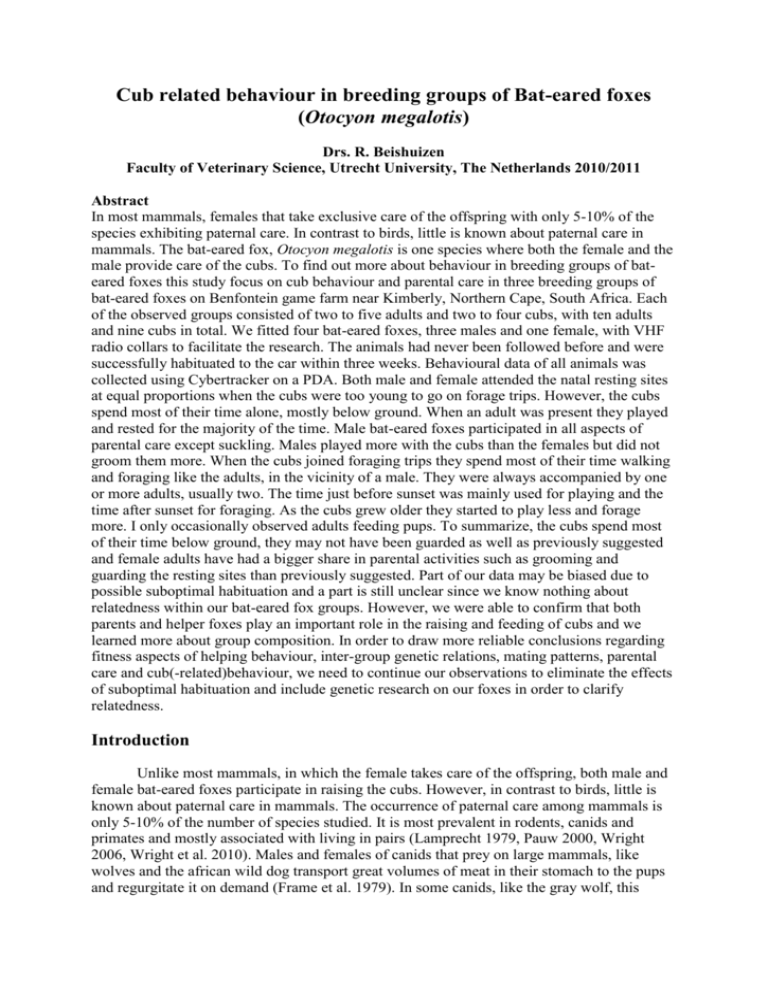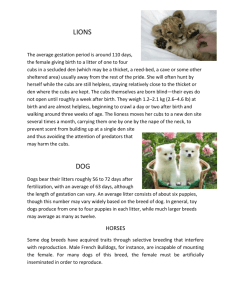Pup-related behaviour in the Bat-eared fox
advertisement

Cub related behaviour in breeding groups of Bat-eared foxes (Otocyon megalotis) Drs. R. Beishuizen Faculty of Veterinary Science, Utrecht University, The Netherlands 2010/2011 Abstract In most mammals, females that take exclusive care of the offspring with only 5-10% of the species exhibiting paternal care. In contrast to birds, little is known about paternal care in mammals. The bat-eared fox, Otocyon megalotis is one species where both the female and the male provide care of the cubs. To find out more about behaviour in breeding groups of bateared foxes this study focus on cub behaviour and parental care in three breeding groups of bat-eared foxes on Benfontein game farm near Kimberly, Northern Cape, South Africa. Each of the observed groups consisted of two to five adults and two to four cubs, with ten adults and nine cubs in total. We fitted four bat-eared foxes, three males and one female, with VHF radio collars to facilitate the research. The animals had never been followed before and were successfully habituated to the car within three weeks. Behavioural data of all animals was collected using Cybertracker on a PDA. Both male and female attended the natal resting sites at equal proportions when the cubs were too young to go on forage trips. However, the cubs spend most of their time alone, mostly below ground. When an adult was present they played and rested for the majority of the time. Male bat-eared foxes participated in all aspects of parental care except suckling. Males played more with the cubs than the females but did not groom them more. When the cubs joined foraging trips they spend most of their time walking and foraging like the adults, in the vicinity of a male. They were always accompanied by one or more adults, usually two. The time just before sunset was mainly used for playing and the time after sunset for foraging. As the cubs grew older they started to play less and forage more. I only occasionally observed adults feeding pups. To summarize, the cubs spend most of their time below ground, they may not have been guarded as well as previously suggested and female adults have had a bigger share in parental activities such as grooming and guarding the resting sites than previously suggested. Part of our data may be biased due to possible suboptimal habituation and a part is still unclear since we know nothing about relatedness within our bat-eared fox groups. However, we were able to confirm that both parents and helper foxes play an important role in the raising and feeding of cubs and we learned more about group composition. In order to draw more reliable conclusions regarding fitness aspects of helping behaviour, inter-group genetic relations, mating patterns, parental care and cub(-related)behaviour, we need to continue our observations to eliminate the effects of suboptimal habituation and include genetic research on our foxes in order to clarify relatedness. Introduction Unlike most mammals, in which the female takes care of the offspring, both male and female bat-eared foxes participate in raising the cubs. However, in contrast to birds, little is known about paternal care in mammals. The occurrence of paternal care among mammals is only 5-10% of the number of species studied. It is most prevalent in rodents, canids and primates and mostly associated with living in pairs (Lamprecht 1979, Pauw 2000, Wright 2006, Wright et al. 2010). Males and females of canids that prey on large mammals, like wolves and the african wild dog transport great volumes of meat in their stomach to the pups and regurgitate it on demand (Frame et al. 1979). In some canids, like the gray wolf, this behaviour is not only displayed by the parents of the pups but also by other members of the group (Asa and Valdespino 1998). Other parental behaviour displayed by both male and female gray wolves includes guarding of the pups and playing with them (Asa and Valdespino 1998). Canids that prey on medium sized mammals often do not regurgitate, but males and females instead carry the meat to the pups in their mouth (Kauhala et al. 1998). Kleiman and Malcolm (1981) compared different aspects of reproductive biology between different canids and found that a lot of species display male parental care in a lot of different ways, both indirect and direct. Indirect investments, like provisioning the female, resource acquisition, maintenance and defence of territory indirectly benefit the young. These investments are difficult to observe and quantify and consequently ignored in most studies. Direct investments, like huddling, grooming and playing, directly benefit the young and have been observed in 9-10% of the mammalian genera. Though information regarding parental care is sparse, both direct and indirect male parental care is commonly observed in odd-toed ungulates, carnivores and primates and may be more common than what currently has been found in rodents and insectivores (Kleiman and Malcolm 1981). The bat-eared fox is a small nocturnal carnivore which weighs approximately 4kg (Estes 1992, Kamler and Macdonald 2006, Nel and Maas 2004). They inhabit a range of habitats, from dry open plains and open woodlands to shrubby grasslands. Bat-eared foxes are distributed in two discrete populations in Eastern and Southern Africa, separated by about a thousand kilometres (Kuntzsch and Nel 1992). They predominantly feed on harvester termites Hodotermesmossambicus or Microhodotermesviator (Kuntzsch and Nel 1992, Nel and Mackie 1990) supplemented by plant material, other insects and occasionally small animals during the winter when termite availability is low (Kok and Louw 2000, Kuntzsch and Nel 1992, Nel 1984, Nel 1990). Most of the foraging takes place in small social groups (Nel and Kok 1999). Bat-eared foxes have many predators. Lions, leopards, cheetahs and brown hyenas have all been seen capturing adults, and black-backed jackals pose the biggest threat to cubs (Pauw 2000). Bat-eared foxes breed annually and mostly live in socially monogamous, nonterritorial pairs (Maas 1993, Pauw 2000, Wright 2010). Pauw (2000) described a sexually polygynous group in the Kalahari which consisted of a male, two lactating females and a litter of five cubs. It is yet unknown if pairs mate for life. Pair bonding and mating has only been noted during July and August (Nel 1984). The pair copulates for up to ten times a day for several days, with a copulatory tie lasting for about four minutes (Nel and Maas 2004). Breeding adults excavate dens or adapt dens of other mammals, these are used for protection against predators and the elements (Lamprecht 1979, Nel and Maas 2004). From October to December, females give birth in a den to 4-6 cubs after a 60-70 day gestation period (Nel and Maas 2004). Juvenile mortality is high, especially in the three weeks the cubs are confined to the den, due too extreme temperatures and flooding. The cubs are weaned at ten to fifteen weeks and leave the den at the age of six months. Young females come into oestrus at the age of eighteen months (Estes 1992, Nel 1984, Wright 2010), young males already at eight to nine months (Nel and Maas 2004). Male bat-eared foxes are involved in all aspects of raising the cubs, except suckling, and spend a lot of the time in the vicinity of the cubs (Pauw 2000, Wright 2006, Wright et al. 2010). Females spend most of their time away from the cubs foraging, which is necessary to sustain lactation (Maas 1993). This is most likely attributed to the adult’s predominant food source, termites, which cannot easily be taken back to the den in any form other than milk (Maas 1993). The aim of the project was to examine parental care related behaviour on bat-eared foxes, both on adults as well as quantify data on cubs during pre-weaning and weaning periods. The specific objectives of the study were: 1) specify and quantify adult foraging, resting and grooming behaviour and social behaviour between adults 2) specify and quantify cub foraging, resting and grooming behaviour and social behaviour between cubs 4) specify and quantify interactions between male adults and cubs and female adults and cubs 5) quantify forage areas of adults in relation to the presents of cubs Methods Study area The study was conducted between November 2010 and February 2011 at Benfontein Nature Reserve, Kimberley, in Northern Cape of South Africa, latitude. 28.8166667°, longitude. 24.8166667° (figure 1). This reserve is an 11, 000 hectare game farm consisting of dry Karoo, grassland and Kalahari savannah. In this area there is a healthy population of bat-eared foxes, making it a very suitable place to study them (Kamler and Macdonald 2006). Figure 1. Map of Benfontein Nature Reserve. www.diamondroute.co.za Study animals Four bat-eared foxes (figure 2) from two groups were fitted with vhf-collars. The foxes were captured using traps baited with offal and immobilized with ketamine hydrochloride and medetomidine hydrochloride, which subsequently was reversed with atipamezole (Yorkstone Wright 2006). All captures were cleared by the animal use and care committee at the University of Pretoria. The animals had been captured one week prior of my arrival and had to be habituated first to make any Figure 2. Bat-eared fox BFM10011. research possible. The process involved following them at a Photograph taken by R. Beishuizen distance that they were comfortable with. For all four animals this was about fifty meter. The more comfortable they were around the car the closer we managed to observe them. They were never observed from outside the car. This process took about two weeks in total, after which the animals were approachable to about five to ten meters without showing obvious changes in behaviour. Three of the four foxes were males, one was female and they were part of three groups (table 1). The female (BFF10009) was part of group 1 with one other adult fox. One male (BFM10008), captured in the same area as the female, was part of an adjacent group (group 2) with two other adult foxes. These groups slept at different resting sites but foraged in the same areas and had been observed together on numerous occasions. The two other males (BFM10010 and BFM10011) were still subadult animals when captured, and part of a third group (group 3) with two other foxes, one adult and one subadult. Through following each collared animal, mostly foraging in groups, we started to recognise individual animals based on behaviour, scars, size and fur colour. This way it was possible for us to reliably follow animals without collars when encountered in the field or at a resting site. Tracking and tracing of the animals We used VHF (very high frequency) radio transmitters from SirTrack (www.sirtrack.com) to relocate the foxes. We relocated animals twice daily, once during the day to locate the animals resting sites and during the evening when tracking the animals. Behavioural data In order to log the behavioural data we used a PDA programmed with the software Cybertracker (www.cybertracker.org). We scored walking, running, foraging, suckling, resting, huddling, grooming, social grooming and playing behaviour (table 2). In the case of social interactions we had boxes that you could tick to specify which other animal was part of the interaction. For other behaviours or comments we used the comment box that appeared after each collection. Table 2. Ethogram Behaviour Walking Running Foraging Grooming Social grooming Playing Resting Huddling Correcting Feeding Suckling Sand bathing Description Moving around slowly, including stops to look around Moving around fast, not chasing or following something All behaviours associated with eating, chewing and digging, jumping or searching for food Licking own fur Licking the fur of another bat-eared fox Chasing, pushing, biting each other and/or digging (playfully and not searching for food) Lying down by itself or together but not touching each other Lying together with other bat-eared fox(es), touching each other Snapping or barking at other bat-eared fox(es) Carrying and dropping a food item in front of a cub Female actively standing still to allow the cubs to drink milk Rolling and/or rubbing around in a patch of loose sand From the dates when we first observed cubs we started with the den observations to quantify group composition, baby-sitting behaviour of male foxes versus female foxes, interactions between cubs and interactions between cubs and adults. These den observations constituted a one to two hour close observation period of a particular resting site were cubs were present. We observed the cubs of group 1 for 188 minutes, cubs of group 2 for 354 minutes and cubs of group 3 for 197 minutes in total. We used an ad libitum sampling method and recorded specified behaviour (table 2) of every animal (Altmann, 1974). During the den observations we logged behaviour of adults when present and all interactions between cubs, cubs and adults and between adults. We observed and logged cub behaviour at the resting site 34 minutes for group 1, 54 minutes for group 2 and 59 minutes for group 3. We further noted the number of adults present, the number of cubs present above ground and below ground, the behaviours they were showing and the timeframe of it all. When we followed adults foraging we used a focal sampling method for two or three hours (Altmann, 1974). When the cubs started to join the parents foraging, with one, two or three adults, we followed them and recorded the behaviour of one of the adult foxes for one to two hours and subsequently recorded the behaviour of one of the cubs for an additional one to two hours. In tall grass we had to switch from this focal sampling method to the ad libitum sampling method because it was too difficult to observe one particular animal (Altmann, 1974). The observations of foraging trips with cubs only include group 3, since group 1 and group 2 were unreachable for a large period of time due to heavy rain, and total a 269 minutes. The total amount of data we collected for each aspect of our study is summarized in table 3. Table 3. Amount of data collected in minutes Group 1 Resting site attendance 188 Cub behaviour at the resting site 34 Cub behaviour during forage trips 0 Group 2 354 54 0 Group 3 197 59 269 Spatial data To collect spatial data we used a handheld GPS from Garmin (www.garmin.com). During the day we located the animals and noted the specific gps position as a resting site. When following the animals in the evening and at night we recorded their tracks with the gps and noted the specific gps position of any scat sites. We then plotted the gps positions of the resting and scat sites and the tracks using ESRI Arcgis 9.3 (http://www.esri.com/software/arcgis/index.html). Using the tracks in Arcgis we created line densities to clarify the foxes foraging areas. Data analysis For the resting site attendance data we calculated the time the cubs spend alone, with the male, the female or both adults and the time they were below or above ground when alone. All these observations in minutes were then converted into a percentage of the calculated total observation time. For the cub and adult behaviour we calculated the amount of time that was spend on recorded behaviour in total. Each total behaviour time in minutes was then converted into a percentage of the calculated total observation time. We compared all this data non-statistically and carefully drew conclusions when possible. Results Group composition We first observed bat-eared fox cubs at November 20 (group 2), at December 5 (group 1) and 6 (group 3). BFF10009 in group 1 had four cubs, and there was only one other adult present in this group. BFF10009 was the mother of the cubs and the other fox is the father. Group 2, which included male BFM10008 and two other foxes, had two cubs. One fox, the only one observed suckling the cubs, was presumably the mother. BFM10008 was seen socialising with the cubs on numerous occasions, to the contrary of the other fox, which leads us to presume that BFM10008 was the father. Group 3 split up for a while creating two new groups when three cubs were born. BFM10011 remained with the three cubs and two other foxes. One fox, the only one observed suckling the cubs, was presumably the mother. BFM10011 was likely too young to be mating, which suggest that the other fox was the father. BFM10010 moved in to a different resting site and was later seen together with another fox. There was no cubs observed at this site, and he re-joined the old group at the end of December together with the additional fox. The number of adults and cubs observed in the different groups are summarized in table 1. Table 1. Study Animals ID Collar Animal Group 1 BFF10009 Group 2 BFM10008 Group 3 BFM10010 and BFM10011 Number of adults 2 3 5 Number of cubs 4 2 3 Cub age The three different nests were discovered the first time at November 20 (group 2), at December 5 (group 1) and 6 (group 3). Since the cubs are confined to the den the first three weeks and they start to emerge briefly at the age of eight to twelve days, they were all probably in the range of one to three weeks old at these times. Judging by size the cubs in group 1 were closer to one week and the cubs in groups 2 and 3 closer to three weeks, maybe even older. At the end of the study all the cubs were still below weaning age, between eight and ten weeks old. We observed that as the cubs grew older that they started to forage more and play less, but we still observed suckling throughout the observation period. Forage area The three groups of bat-eared foxes always foraged near their resting sites. Group 2 and 3 foraged around their resting site, group 1 foraged around group 2’s resting site and in an area between. All these foraging areas are approximately the same size, ranging from 0,5km2 to 1km2. Although not tested statistically, my data suggest that BFM10010, without cubs, (Figure 3a) utilized a greater area to forage than BFM10011, with cubs (Figure 3b). Resting site attendance When the cubs Figure 3a. Figure 3b. Spatial data converted into line densities, for BFM10010 (without cubs) in figure 3a and for BFM10011 (with cubs) in figure 3b. Areas that are darker blue represent areas with more tracks. The lightest blue areas do not have tracks. Resting site attendance When the cubs were too young to go on forage trips they stayed in or around the resting site. Cubs of group 3 spend 173 out of a total of 197 observation minutes (88%) alone, cubs of group 2 spend 244 out of a total of 354 observation minutes (69%) alone, and cubs of group 1 spend 152 out of a total of 188 observation minutes (81%) alone (table 4). In group 2, the female attended the resting site alone 46 out of a total of 354 observation minutes (13%) and BFM10008 attended the resting site alone for 55 minutes (15.5%). They attended the resting site together for 9 minutes (2.5%). The third bat-eared fox in this group attended with the female for 12 minutes (3.3%) but was never observed to attend alone. There were 9 interactions observed between adults and cubs, consisting of suckling, social grooming and playing. In group 1 neither of the adults attended the resting site alone. They attended together for 35 minutes out of a total of 188 minutes of observation (19%). There were no observed interactions between cubs and adults. In group 3 the male attended the resting site for 6 minutes out of 197 minutes of observation (3%), the female attended for 7 minutes (4%), and they attended together for 10 minutes (5%). The third fox in this group did not attend the resting site. There were 5 interactions observed between adults and cubs, consisting of playing, social grooming, huddling, sniffing, feeding and a try of the cubs to suckle which was rejected by the female. Table 4. Den attendance as a percentage of total time that resting site was observed. Total observation time is 188 minutes for cubs group 1, 354 minutes for cubs group 2 and 197 minutes for cubs group 3. Alone Only female Only male present Both adults present present 81% 0% 0% 19% Cubs group 1 69% 13% 15.5% 2.5% Cubs group 2 88% 4% 3% 5% Cubs group 3 Average 79% 6% 6% 7% When the cubs were alone at the resting sites they spend most of the time below ground. The cubs of group 1 were in total 31 minutes (23%) above ground and 122 minutes (77%) below ground out of a total of 135 observation minutes spend alone. The cubs of group 2 were in total 6 minutes (3%) above ground and 183 minutes (97%) below ground out of a total of 189 observation minutes spend alone. The cubs of group 3 were in total 60 minutes (39%) above ground and 75 minutes (61%) below ground out of a total of 153 observation minutes spend alone (table 5). Table 5. Percentage of time cubs spend above or below ground when alone at the resting site. Total observation time is 135 minutes for cubs group 1, 189 minutes for cubs group 2 and 153 minutes for cubs group 3. Above ground Below ground 23% 77% Cubs group 1 3% 97% Cubs group 2 39% 61% Cubs group 3 Average 22% 78% Cub behaviour at the resting sites The two main cub behaviours at resting sites were play and rest. The cubs in group 1 spend 31 minutes (91%) playing and 9 minutes (9%) resting out of a total observation time of 34 minutes. Group 2 spend 24 minutes (44.4%) playing and 23 minutes (42.5%) resting out of a total observation time of 54 minutes. Group 3 spend 5 minutes (8.5%) playing and 32 minutes (54.2%) resting out of a total observation time of 59 minutes. Although all adult bat- eared foxes played with the cubs, our observations suggest that males played more with the cubs than the females. In group 1 and 2 we did not observe the male or the female playing with the cubs. In group 2 the male played 14 minutes (25.9%) out of a total observation time of 54 minutes with the cubs while we did not observe the female playing with the cubs. Play consisted of chasing, pushing, biting each other and/or digging. All other social interactions, like grooming, suckling, huddling and correction seemed to take place mainly at the resting site, although we did observe these behaviours during the beginning of foraging trips as well. There were three accounts of females suckling her young. Each time it only took about two minutes. It did not happen at consistent times, but all observations were at the resting sites. There does not seem to be a difference in the amount of time males or females spend grooming the cubs. In group 2 the female spend 3 minutes (5.6%) out of a total of 54 observation minutes at grooming the cubs, the male 1 minute (1.9%). In group 3 the female spend 2 minutes (3.4%) out of a total of 59 observation minutes at grooming the cubs, the male 1 minute (1.7%). The third fox in group 2 and the third fox in group 3 were not seen to interact with the cubs (table 6). Table 6. Cub behaviour observed at resting site presented as percentage of total time. Total observation time is 34 minutes for cubs group 1, 54 minutes for cubs group 2 and 59 minutes for cubs group 3. Playing with each other Playing with male Grooming Grooming each other Grooming with female Grooming with male Resting Huddling with each other Suckling Foraging Cubs group 1 Cubs group 2 Cubs group 3 91% 18.5% 25.9% 8.5% 9% 5.6% 1.9% 42.5% 3.4% 8.5% 3.4% 1.7% 54.2% 18.6% 5.6% 1.7% Cub behaviour during forage trips When the cubs were out on a forage trip they mainly walked and foraged, 188 minutes out of a total observation time of 269 minutes (69.9%) was spend on these activities. On foraging trips the cubs where followed by either the male alone, by the female alone or by both adults. When both adults were present the cubs spent most of their time in the vicinity of the male. Sometimes the cubs split up, in which one cub joins the male on a forage trip and the other two join the female on a forage trip. We also observed this the other way around. Most of the time however, both adults were present on a forage trip. On a couple occasions a third adult was present as well. The cubs walked and foraged with the third fox but no social interactions were observed. Playing and other social interactions seem to take place at the beginning of the evening. The cubs appeared to spend more time playing with the male then with the female, 6 minutes (2.2%) and 3 minutes (1.1%) of active time, respectively. We only observed the female huddling with the cubs and only observed the male bringing the cubs food objects. For other social interactions there did not seemed to have been a difference between male and female (table 7). Table 7. Cub behaviour observed during forage trips Presented as percentage of total time (269 minutes). Cubs group 3 Playing with each other Playing with female Playing with male Grooming Grooming with female Grooming with male Huddling with female Suckling attempt Corrected by other cub Corrected by male Fed by male Foraging/Walking 3.4% 1.1% 2.2% 2.2% 0.7% 0.7% 16.8% 0.4% 0.4% 0.7% 1.5% 69.9% The cubs foraged in the same way that the adults do. They walked for short distances and foraged a couple of seconds before moving on. Sometimes they caught an insect from the air, which we also observed the adults do. However, we did observe cubs feeding directly of termite mounds, which we never observed the adults do. On three occasions we observed a male bringing a large insect to the cubs. On two occasions this was during a forage trip, on the other occasion it was at the resting site. The cubs started playing with it, when it escaped the male brought it back to the cubs and they eventually ate it. On three accounts I observed adult bat-eared foxes eating faeces from other animals, most likely herbivore judging by the amount of plant material in it. On two accounts an adult male brought a piece of faeces to the cubs. The cubs started to play with it and eventually ate it. Other behaviour BWM10011 has been seen sand bathing on two occasions. Both times the cubs were trying to imitate this behaviour, rather unsuccessfully, and on both times it ended in playing with BWM10011. Discussion Social organisation and mating patterns Most canids live in large groups and exhibit monogamy (Asa and Valdespino 1998, Kleiman and Malcolm 1981). One of our groups of bat-eared foxes consisted of two adult individuals and two groups consisted of more than two adult individuals. These observations support previous studies suggesting that bat-eared foxes are a pair-living or group-living species like other canids (Lamprecht 1979, Maas 1993, Nel 1984, Nel and Kok 1999). However, group composition should not be confused with mating system. We have not seen any of the bat-eared foxes mate, so we cannot be sure whether the additional foxes in the two larger groups are either helpers or mating partners. We believe that the two groups are most likely sexually monogamous, as in all other canids (Asa and Valdespino 1998). The additional foxes would then be related or unrelated helpers, which has been suggested in most of the studies of bat-eared fox mating patterns (Estes 1992, Maas 1993, Wright 2010), although Pauw (2000) described one out of twelve groups as polygamous. Anti-predatory defence and increased vigilance could account for the observation of additional adults beyond the breeding pair (Pauw 2000). With the large amount of animals that predate on bat-eared foxes, more animals could mean enhanced fitness through an increase in the chance of spotting a predator in time, both because the adult foxes do not have to forage alone and because the cubs spend less time unguarded (Pauw 2000). This increases the inclusive fitness for the parents because they are able to support more offspring, because more offspring (including the helpers) will survive and because their own chance of survival will increase, enabling them to reproduce for another year. All these benefits explain why parents would allow a cub to stay with the group as a helper but do not explain entirely why a particular bat-eared fox would assist a breeding pair instead of dispersing and reproducing on their own. An explanation for the helping behaviour could lie in the fact that remaining in the natal pack offers more benefits than dispersing. Dispersing could lead to reproducing but also comes with costs, most likely decreasing the amount of offspring the helper is able to produce and support. Benefits from remaining in the natal pack include an increase in their own chance of survival, enabling them to reproduce the next year, and an increase in the chance of cub survival. Since these cubs share the same parents as the helper, they share the same genes and can be seen as equivalents of the helpers own offspring. We can conclude that remaining in the natal pack increases the inclusive fitness for the helpers because they are able to produce and support more offspring equivalents (Mumme et al. 1989). Helping behaviour is also observed in other canids. For example, Harrington et al. (1983) found that older gray wolf siblings fed pups, but only when prey density was high enough. Geffen and Macdonald (1992) found that Blanford’s fox females sometimes remain on their parents territories but do not assist with the cubs, they propose that this might be explained by their intervertebrate food source which opposes our findings. Forage areas The three groups of bat-eared foxes had forage areas of approximately 0,5km2 to 2 1km , partly corresponding with other literature. Nel and Mackie (1990) found widely overlapping forage area’s ranging from smaller than 1km2 to larger than 3km2 and Nel (1984) found overlapping forage area’s ranging from 0,5km2 to 3km2. However our observations also suggested something else, namely that BFM10010 without cubs utilised a greater area to forage compared to BFM10011 with cubs in his group. A reason for this could be that bateared foxes stay closer to their resting sites when accompanying cubs. However, it could also be caused by individual differences in space use, and it will not be possible to distinguish these two explanations unless more data is collected on space use in groups with and without cubs present. Resting site attendance We observed that cubs spent a large amount of time unguarded at the resting site. We also observed that both males and females guarded the resting site together and alone and that there was not a difference in the amount of time they did. These observations contradict expectations based on high cub mortality from predation. One possible explanation could be poor habituation of the adult bat-eared foxes, which were less relaxed in our presence when approached at the resting site compared to when they were approached foraging. Therefore, we may have biased our data regarding parental attendance at resting sites. The lack of difference between female and male resting site attendance also contradicts Pauw’s study (2000), he found that females do not guard the resting site. Cub related behaviour Most canids, like our bat-eared foxes, exhibit male and female parental care like feeding behaviour (Asa and Valdespino 1998, Kleiman and Malcolm 1981). For example, males and females of canids that prey on large mammals, like wolves and the African wild dog transport great volumes of meat in their stomach to the pups and regurgitate it on demand (Frame et al. 1979). In gray wolves this behaviour is not only displayed by the parents but also by other animals of the group (Asa and Valdespino 1998). Canids that prey on small animals, like the arctic, fennec or red fox also feed their cubs but do so by bringing the prey itself to the resting site. Other parental behaviour is also observed in other canids (Kleiman and Malcolm 1981). In gray wolves and African wild dogs both male and female guard the pups and play with them, male African wild dogs even carry and groom their pups, which we also observed in the bat-eared foxes (Asa and Valdespino 1998). There are contradicting data as to whether or not this paternal care in the bat-eared fox is necessary to breed successfully. Bat-eared foxes produce large litters of well-developed young, and Maas (1993) observed a widowed female successfully raise cubs. Combined, these observations suggest that females are capable of raising their young without paternal assistance. However, this female was aided by an unusually high availability of food, and may not have been able to raise her cubs successfully and satisfy her own need for food under normal circumstances (Maas 1993, Moehlman 1989, Wright 2006). Specific behaviour we observed did not stroke entirely with other literature on bateared foxes. We observed males to play more with the cubs than females, but that they did not groom the cubs more. Pauw (2000) observed that the males both played with and groomed cubs more than the females. These discrepancies could be explained if the cubs we observed in the present study groomed themselves more, but unfortunately Pauw (2000) did not record these behaviours. What should be noted is that social grooming typically has a social importance extending far beyond the physical need of cleaning the fur (Estes 1992, Maas 1993). Social grooming might help in bonding between adults and cubs. Also in contrast to observations by Pauw (2000), we observed females guarding the cubs at resting sites. A possible explanation for this difference could be that insects are more abundant in our study area. Such a difference could mean that the females can spend less time foraging and more time guarding the cubs. Summary and brief outlook This study allowed for quantification of the composition of bat-eared fox groups in our study area. In the future it would also be valuable to know relatedness within groups, as well as parental data. Data on relatedness could be particularly useful to explore fitness aspects of helping behaviour, inter-group genetic relations and mating patterns. Since our observations that the cubs still spend most of their time unguarded may be biased due to poor habituation, it would also be useful to get additional data on bat-eared foxes that are well habituated at the resting site. A lot of our observations are seen in other canid species. However, comparisons are difficult since field observations on other canids are extremely limited, especially for other foxes (Kleiman and Malcolm 1981). To conclude, bat-eared fox cubs were not guarded as well as was previously found in other studies, they spend most of their time below ground when alone and female adults had a bigger share in aspects like grooming and guarding the resting site then has been found in previous studies. Part of our data may be biased due to possible suboptimal habituation and a part is still unclear since we know nothing about relatedness within our bat-eared fox groups. However, we were able to confirm that both parents and helper foxes play an important role in the raising and feeding of cubs and we learned more about group composition, in order to draw more reliable conclusions regarding fitness aspects of helping behaviour, inter-group genetic relations, mating patterns, parental care and cub(-related)behaviour, we need to continue our observations to eliminate the effects of suboptimal habituation and include genetic research on our foxes in order to clarify relatedness. References Altmann, J. (1974) Observational study of behaviour: sampling methods. Behaviour 49: 227265. Asa, C.S. Valdespino, C. (1998) Canid reproductive biology: an integration of proximate meachanisms and ultimate causes. American zoology 38: 251-259 Estes, R. (1992) The behavior guide to African mammals. University of California Press 22: 392-398 Frame, L.H. Malcolm, J.R. Frame, G.W. Lawick, van H. (1979) Social organisation of african wild dogs (Lycaon pictus) on the Serengeti plains, Tanzania. Zeitschriftfürtierpsychologie 50: 225-249 Geffen, E. Macdonald, D.W. (1992) Small size and monogamy: spatial organization of Blanford’s foxes, Vulpes canis. Animal behaviour 44: 1123-1130 Harrington, F.H. Mech, L.D. Fritts, S.H. (1983) Pack size and wolf pup survival: their relationship under varying ecological conditions. Behavioral ecology and sociobiology 13: 126 Kamler, J.F. Macdonald, D.W. (2006) Longevity of a wild bat-eared fox. South African Journal of Wildlife Research 36: 199-200 Kauhala, K. Helle, E. Pietila, H. (1998) Time allocation of male and female raccoon dogs to pup rearing at the den. Actatheriologica 43: 301-310 Kleiman, D.G. Malcolm, J.R. (1981) The evolution of male parental investment in mammals. Parental care in mammals 9: 347-387 Kok, O.B. Louw, S v.d. M (2000) Avian and mammalian predators of Orthoptera in semi-arid regions of South-Africa. South-African Journal of Wildlife Research 30: 122-128 Kuntzsch, V. Nel, J.A.J. (1992) Diet of bat-eared foxes Otocyon megalotis in the Karoo. Koedoe. 35: 37-48 Lamprecht, J. (1979) Field observations on the behaviour and social system of the bat-eared fox, Otocyon megalotis desmarest. Zeitschrift fur Tierpsychologie 49: 260-284 Maas, B. (1993) Behavioural ecology and social organisation of the bat-eared fox in the Serengeti National Park, Tanzania. Ph.D. Thesis University of Cambridge Moehlman, P.D. (1989) Intraspecific variation in Canid social systems. In Carnivore Behavior, Ecology and Evolution: 143-163 Gittleman, J.L. Mumme, R.L. Koenig, W.D. Ratnieks, F.L. (1989) Helping behaviour, reproductive value, and the future component of indirect fitness. Animal behaviour 38: 331-343 Nel, J.A.J. (1984) Behavioural ecology of canids in the South-Western Kalahari. Koedoe 27: 225-239 Nel, J.A.J. Mackie, A.J. (1990) Food and foraging behaviour of bat-eared foxes in the Southeastern Orange Free State. South African Journal of Wildlife Research 20: 162-166 Nel, J.A.J. Maas, B. (2004) Bat-eared fox, Otocyon megalotis desmarest. IUCN Red List of Threatened Species 6: 183-189 Nel, J.A.J. (1990) Foraging and feeding by bat-eared foxes Otocyon megalotis in the southwestern Kalahari. Koedoe 33: 9-16 Nel, J.A.J. Kok, A.B. (1999) Diet and foraging group size in the yellow mongoose: a comparison with the suricate and bat-eared fox. Ethology, Ecology and Evolution 11: 25-34 Pauw, A. (2000) Parental care in a polygynous group of bat-eared foxes, Otocyon megalotis. African Zoology 35: 139-146 Wright, H.W.Y. (2006) Paternal den attendance is the best predictor of offspring survival in the socially monogamous bat-eared fox. Animal Behaviour 71: 503-510. Wright, H.W.Y. Gray, M.M. Wayne, R.K. Woodroffe, R.B. (2010) Mating tactics and paternity in a socially monogamous canid, the bat-eared fox (Otocyon megalotis). Journal of mammology 91: 437-446





